Effects of Varied Tillage Practices on Soil Quality in the Experimental Field of Red-Soil Sloping Farmland in Southern China
Abstract
1. Introduction
2. Materials and Methods
2.1. Study Site Description
2.2. Experimental Design and Analyses of Soil-Sampling Indicators
2.3. Soil Quality Evaluation Methods
2.3.1. Establishment of the MDS
2.3.2. Soil Quality Index Calculation (SQI)
2.3.3. Accuracy Verification of SQI Evaluation
2.4. Data Analyses
3. Results
3.1. Changes in Soil Physical Properties Under Different Tillage Practices
3.1.1. Soil Water-Retention Characteristics
3.1.2. Soil Aggregate Characteristics
- (1).
- Characteristics of Soil Aggregate Distribution
- (2).
- Soil Aggregate Stability
3.2. Changes in Soil Chemical Properties Under Different Tillage Practices
3.3. Changes in Soil Quality Under Different Tillage Practices
3.3.1. Establishing a MDS for Soil Quality Assessment
3.3.2. Rational Validation of MDS and Soil Quality Evaluation
4. Discussion
4.1. Effect of Tillage Practices on Soil Quality in Red-Soil Slopes
4.2. Effect of Crop Growth Stages on Soil Quality in Red-Soil Sloping Farmland
5. Conclusions
Author Contributions
Funding
Institutional Review Board Statement
Informed Consent Statement
Data Availability Statement
Conflicts of Interest
References
- Xue, J.; Zhang, X.; Chen, S.; Lu, R.; Wang, Z.; Wang, N.; Hong, Y.; Chen, X.; Xiao, Y.; Ma, Y.; et al. The validity domain of sensor fusion in sensing soil quality indicators. Geoderma 2023, 438, 116657. [Google Scholar] [CrossRef]
- Chen, E. Causes of maturation and development of tilling depth and gradation of agricultural soil. J. Shenyang Agric. Univ. 1975, 2, 25–34. [Google Scholar]
- Karlen, D.L.; Veum, K.S.; Sudduth, K.A.; Obrycki, J.F.; Nunes, M.R. Soil health assessment: Past accomplishments, current activities, and future opportunities. Soil Tillage Res. 2019, 195, 104365. [Google Scholar] [CrossRef]
- Sun, J.; Niu, W.; Du, Y.; Zhang, Q.; Li, G.; Ma, L.; Zhu, J.; Mu, F.; Sun, D.; Gan, H.; et al. Combined tillage: A management strategy to improve rainfed maize tolerance to extreme events in northwestern China. Agric. Water Manag. 2023, 289, 108503. [Google Scholar] [CrossRef]
- Jin, H.; Shi, D.; Lou, Y.B.; Zhang, J.; Ye, Q.; Jiang, N. Evaluation of the quality of cultivated-layer soil based on different degrees of erosion in sloping farmland with purple soil in China. Catena 2021, 198, 105048. [Google Scholar] [CrossRef]
- Fu, B.J.; Liu, S.L.; Chen, L.D.; Lu, Y.H.; Qiu, J. Soil quality regime in relation to land cover and slope position across a highly modified slope landscape. Ecol. Res. 2004, 19, 111–118. [Google Scholar] [CrossRef]
- Hammac, W.A.; Stott, D.E.; Karlen, D.L.; Cambardella, C.A. Crop, Tillage, and Landscape Effects on Near-Surface Soil Quality Indices in Indiana. Soil Sci. Soc. Am. J. 2016, 80, 1638–1652. [Google Scholar] [CrossRef]
- Shao, W.; Guan, Q.; Tan, Z.; Luo, H.; Li, H.; Sun, Y.; Ma, Y. Application of BP - ANN model in evaluation of soil quality in the arid area, northwest China. Soil Tillage Res. 2021, 21, 104907. [Google Scholar] [CrossRef]
- Zhang, Y.; Liu, H.; Bingham, C. Integrated evaluation of soil fertility based on grey correlation analysis at regional scales. Afr. J. Agric. Res. 2015, 10, 1450–1456. [Google Scholar] [CrossRef]
- de Paul Obade, V.; Lal, R. A standardized soil quality index for diverse field conditions. Sci. Total Environ. 2016, 541, 424–434. [Google Scholar] [CrossRef]
- Larson, W.E.; Pierce, F.J. The Dynamics of Soil Quality as a Measure of Sustainable Management. In Defining Soil Quality for a Sustainable Environment, 2nd ed.; Doran, J.W., Coleman, D.C., Bezdicek, D.F., Stewart, B.A., Eds.; Soil Science Society of America, Inc.: Madison, WI, USA, 1994; Volume 35, pp. 37–51. [Google Scholar] [CrossRef]
- Kahsay, A.; Haile, M.; Gebresamuel, G.; Mohammed, M.; Okolo, C.C. Assessing land use type impacts on soil quality: Application of multivariate statistical and expert opinion-followed indicator screening approaches. Catena 2023, 231, 107351. [Google Scholar] [CrossRef]
- Nunes, M.R.; Karlen, D.L.; Veum, K.S.; Moorman, T.B. A SMAF assessment of U.S. tillage and crop management strategies. Environ. Sustain. Indic. 2020, 8, 100072. [Google Scholar] [CrossRef]
- Yu, P.; Liu, S.; Zhang, L.; Li, Q.; Zhou, D. Selecting the minimum data set and quantitative soil quality indexing of alkaline soils under different land uses in northeastern China. Sci. Total Environ. 2018, 616, 564–571. [Google Scholar] [CrossRef] [PubMed]
- da Luz, F.B.; Da Silva, V.R.; Mallmann, F.J.K.; Pires, C.A.B.; Debiasi, H.; Franchini, J.C.; Cherubin, M.R. Monitoring soil quality changes in diversified agricultural cropping systems by the Soil Management Assessment Framework (SMAF) in southern Brazil. Agriculture. Ecosyst. Environ. 2019, 281, 100–110. [Google Scholar] [CrossRef]
- Chu, C.; Wu, Z.; Huang, Q.; Han, C.; Zhong, W. Effect of Organic Matter Promotion on Nitrogen-Cycling Genes and Functional Microorganisms in Acidic Red Soils. Environ. Sci. 2020, 41, 2468–2475. [Google Scholar] [CrossRef]
- Guo, J.; Yang, J.; Zhang, L.; Chen, H.; Jia, Y.; Wang, Z.; Wang, D.; Liao, W.; Chen, L.; Li, Y. Lower soil chemical quality of pomelo orchards compared with that of paddy and vegetable fields in acidic red soil hilly regions of southern China. J. Soils Sediments 2019, 19, 2752–2763. [Google Scholar] [CrossRef]
- Schäfer-Landefeld, L.; Brandhuber, R.; Fenner, S.; Koch, H.J.; Stockfisch, N. Effects of agricultural machinery with high axle load on soil properties of normally managed fields. Soil Tillage Res. 2004, 75, 75–86. [Google Scholar] [CrossRef]
- Wang, Y.; Fan, J.; Cao, L.; Zheng, X.; Ren, P.; Zhao, S. The influence of tillage practices on soil detachment in the red soil region of China. Catena 2018, 165, 272–278. [Google Scholar] [CrossRef]
- Jin, H.; Zhong, Y.; Shi, D.; Li, J.; Lou, Y.; Li, Y.; Li, J. Quantifying the impact of tillage practices on the cultivated-layer soil quality in the red soil hilly region: Establishing the thresholds of the minimum data set. Ecol. Indic. 2021, 130, 108013. [Google Scholar] [CrossRef]
- Yang, J.; Zheng, H.; Chen, X.; Shen, L. Effects of tillage practices on nutrient loss and soybean growth in red-soil slope farmland. Int. Soil Water Conserv. Res. 2013, 1, 49–55. [Google Scholar] [CrossRef]
- Puerta, V.L.; Pereira, E.I.P.; Wittwer, R.; Heijden, M.V.D.; Six, J. Improvement of soil structure through organic crop management, conservation tillage and grass-clover ley. Soil Tillage Res. 2018, 180, 1–9. [Google Scholar] [CrossRef]
- Xie, J.; Wang, L.; Li, L.; Coulter, J.A.; Chai, Q.; Zhang, R.; Luo, Z.; Carberry, P.; Rao, K.P.C. Subsoiling increases grain yield, water use efficiency, and economic return of maize under a fully mulched ridge-furrow system in a semiarid environment in China. Soil Tillage Res. 2020, 199, 104584. [Google Scholar] [CrossRef]
- Fang, H.; Liu, F.; Gu, X.; Chen, P.; Li, Y.; Li, Y. The effect of source–sink on yield and water use of winter wheat under ridge-furrow with film mulching and nitrogen fertilization. Agric. Water Manag. 2022, 267, 107616. [Google Scholar] [CrossRef]
- Mao, Y.; Cui, R.; Chen, A.; Ping, F.; Lei, B. Effects of Ridge Directions on Water Characteristic Curves of Cultivated Top-Layer Soils in Different Slope Positions. Chin. J. Soil Sci. 2022, 53, 308–314. [Google Scholar] [CrossRef]
- Ferreira, V.; Panagopoulos, T.; Andrade, R.; Guerrero, C.; Loures, L. Spatial variability of soil properties and soil erodibility in the Alqueva reservoir watershed. Solid Earth 2015, 6, 383–392. [Google Scholar] [CrossRef]
- Ghosh, B.N.; Meena, V.S.; Singh, R.J.; Alam, N.M.; Patra, S.; Bhattacharyya, R.; Sharma, N.K.; Dadhwal, K.S.; Mishra, P.K. Effects of fertilization on soil aggregation, carbon distribution and carbon management index of maize-wheat rotation in the north-western Indian Himalayas. Ecol. Indic. 2019, 105, 415–424. [Google Scholar] [CrossRef]
- Chen, Z.; Shi, D.; He, W.; Xia, J.; Jin, H.; Lou, Y. Spatio-temporal distribution and evolution characteristics of slope farmland resources in Yunnan from 1980 to 2015. Trans. Chin. Soc. Agric. Eng. 2019, 35, 256–265. [Google Scholar]
- Gong, L.; Ran, Q.; He, G.; Tiyip, T. A soil quality assessment under different land use types in Keriya river basin, Southern Xinjiang, China. Soil Tillage Res. 2014, 146, 223–229. [Google Scholar] [CrossRef]
- Liu, X.; Zhang, G.; Heathman, G.C.; Wang, Y.; Huang, C. Fractal features of soil particle-size distribution as affected by plant communities in the forested region of Mountain Yimeng, China. Geoderma 2009, 154, 123–130. [Google Scholar] [CrossRef]
- Nakajima, T.; Lal, R.; Jiang, S. Soil quality index of a crosby silt loam in central Ohio. Soil Tillage Res. 2015, 146, 323–328. [Google Scholar] [CrossRef]
- Yang, X.; Wander, M.M. Temporal changes in dry aggregate size and stability: Tillage and crop effects on a silty loam Mollisol in Illinois. Soil Tillage Res. 1998, 49, 173–183. [Google Scholar] [CrossRef]
- Walkley, A.; Black, I.A. An examination of the Degtjareff method for the determining soil organic matter and proposed modification of the chromic titration method. Soil Sci. 1934, 37, 29–38. [Google Scholar] [CrossRef]
- Bremner, J.M. Determination of nitrogen in soil by the Kjeldahl method. J. Agric. Sci. 1960, 55, 11–33. [Google Scholar] [CrossRef]
- Murphy, J.; Riley, J.P. A modified single solution method for the determination of phosphate in natural waters. Anal. Chim. Acta 1962, 27, 31–36. [Google Scholar] [CrossRef]
- Bao, S. Soil and Agricultural Chemistry Analysis, 3rd ed.; Chinese Agriculture Press: Beijing, China, 2000; pp. 106–107. [Google Scholar]
- Yu, P.; Li, Q.; Jia, H.; Li, G.; Zheng, W.; Shen, X.; Diabate, B.; Zhou, D. Effect of Cultivation on Dynamics of Organic and Inorganic Carbon Stocks in Songnen Plain. Agron. J. 2014, 106, 1574–1582. [Google Scholar] [CrossRef]
- Li, P.; Shi, K.; Wang, Y.; Kong, D.; Liu, T.; Jiao, J.; Liu, M.; Li, H.; Hu, F. Soil quality assessment of wheat-maize cropping system with different productivities in China: Establishing a minimum data set. Soil Tillage Res. 2019, 190, 31–40. [Google Scholar] [CrossRef]
- Nash, J.E.; Sutcliffe, J.V. River flow forecasting through conceptual models part I: A discussion of principles. J. Hydrol. 1970, 10, 282–290. [Google Scholar] [CrossRef]
- Xu, M. Soil Quality Evolvement Mechanism in the Process of Ecosystem Restoration and Its Management in Loess Hilly-Gully Region. Doctor’s Dissertation, Northwest Sci-Tech University of Agriculture and Forestry, Yangling, China, November 2003. [Google Scholar]
- Vilakazi, B.S.; Zengeni, R.; Mafongoya, P. Selected Soil Physicochemical Properties under Different Tillage practices and N Fertilizer Application in Maize Mono-Cropping. Agriculture 2022, 12, 1738. [Google Scholar] [CrossRef]
- Du, R.; Wu, J.; Tian, F.; Yang, J.; Han, X.; Chen, M.; Zhao, B.; Lin, J. Reversal of soil moisture constraint on vegetation growth in North China. Sci. Total Environ. 2022, 865, 161246. [Google Scholar] [CrossRef]
- Williams, J.; Prebble, R.E.; Williams, W.T.; Hignett, C.T. The influence of texture, structure and clay mineralogy on the soil moisture characteristic. Soil Res. 1983, 21, 15–32. [Google Scholar] [CrossRef]
- Xie, C.; Cai, S.; Yu, B.; Yan, L.; Liang, A.; Che, S. The effects of tree root density on water infiltration in urban soil based on a Ground Penetrating Radar in Shanghai, China. Urban For. Urban Green. 2020, 50, 126648. [Google Scholar] [CrossRef]
- Chen, Z.; Zhu, Z.; Zhang, W.; Sun, S. Subsoiling tillage increased core microbiome associated with nitrogen fixation in the fallow season under rainfed maize monoculture. Soil Tillage Res. 2024, 235, 105885. [Google Scholar] [CrossRef]
- Hu, R.; Liu, Y.; Chen, T.; Zheng, Z.; Peng, G.; Zou, Y.; Tang, C.; Shan, X.; Zhou, Q.; Li, J. Responses of soil aggregates, organic carbon, and crop yield to short-term intermittent deep tillage in Southern China. J. Clean. Prod. 2021, 298, 126767. [Google Scholar] [CrossRef]
- Li, W.; Liu, Y.; Zheng, H.; Wu, J.; Yuan, H.; Wang, X.; Xie, W.; Qin, Y.; Zhu, H.; Nie, X.; et al. Complex vegetation patterns improve soil nutrients and maintain stoichiometric balance of terrace wall aggregates over long periods of vegetation recovery. Catena 2023, 227, 107141. [Google Scholar] [CrossRef]
- Mamta; Shambhavi, S.; Kumar, R.; Bairwa, R.; Meena, P.; Meena, M.C. Assessment of Carbon Pools and Stability of Soil Aggregates in Inceptisols of Indo-Gangetic Plains as Influenced by Seven-Year Continuous Tillage practices Under Maize-Based Cropping System. Commun. Soil Sci. Plant Anal. 2023, 54, 544–558. [Google Scholar] [CrossRef]
- Lei, J.; He, J.; Lei, X.; Zhou, L.; Yu, J.; Ji, L.; Zhang, H.; Lu, F. Effects of tillage on soil aggregates and crop yield on gentle slope lands in Southern Ningxia. Agric. Res. Arid. Areas 2020, 38, 245–250. [Google Scholar] [CrossRef]
- Ding, F.; Li, S.; Lu, J.; Penn, C.J.; Wang, Q.; Lin, G.; Sardans, J.; Penuelas, J.; Wang, J.; Rillig, M.C. Consequences of 33 Years of Plastic Film Mulching and Nitrogen Fertilization on Maize Growth and Soil Quality. Environ. Sci. Technol. 2023, 57, 9174–9183. [Google Scholar] [CrossRef]
- Wang, J.; Lu, P.; Valente, D.; Petrosillo, I.; Subhash; Xu, S.; Li, C.; Huang, D.; Liu, M. Analysis of soil erosion characteristics in small watershed of the loess tableland Plateau of China. Ecol. Indic. 2022, 137, 108765. [Google Scholar] [CrossRef]
- Tang, C.; Liu, Y.; Li, Z.; Guo, L.; Xu, A.; Zhao, J. Effectiveness of vegetation cover pattern on regulating soil erosion and runoff generation in red soil environment, southern China. Ecol. Indic. 2021, 129, 107956. [Google Scholar] [CrossRef]
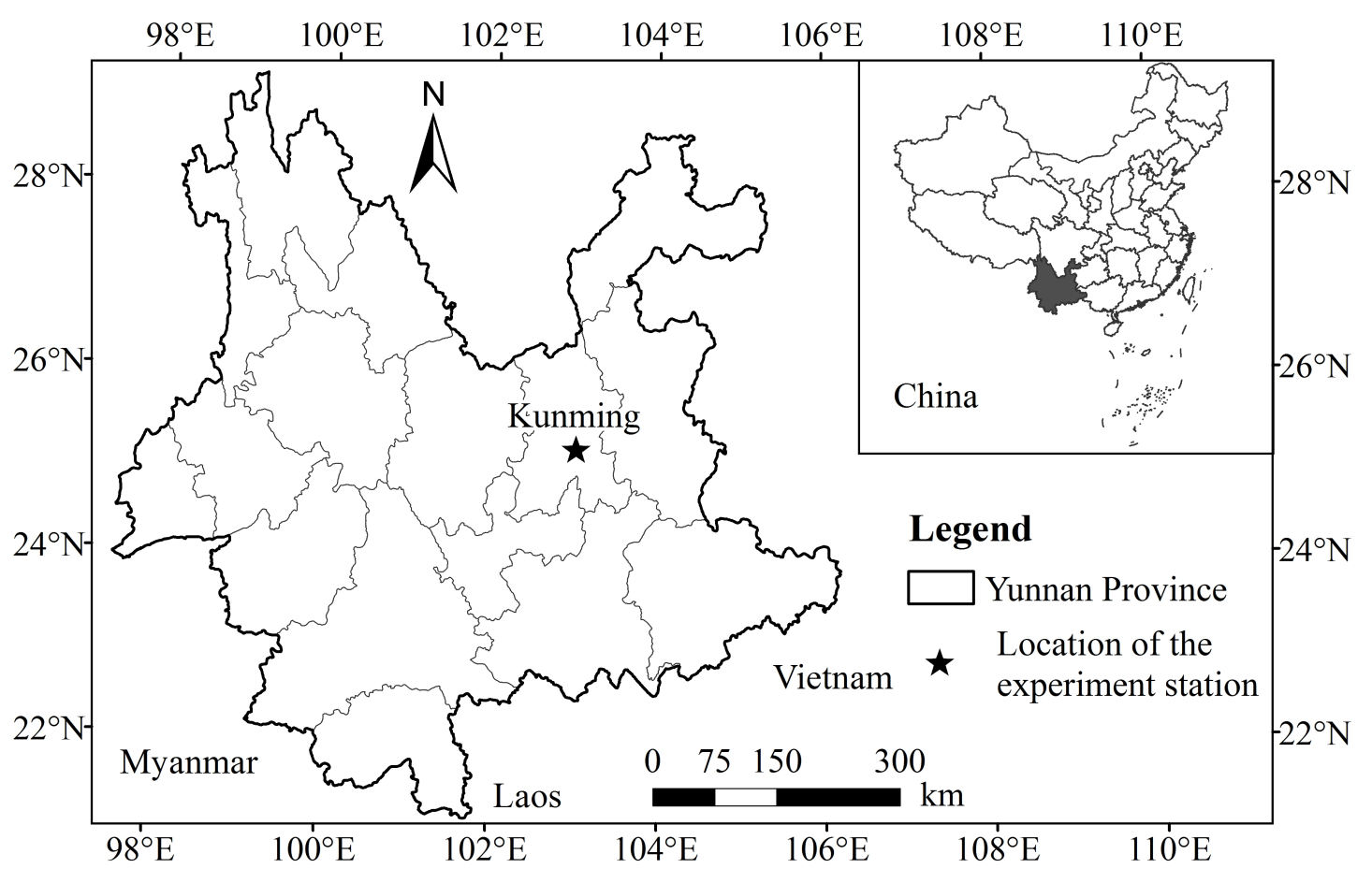
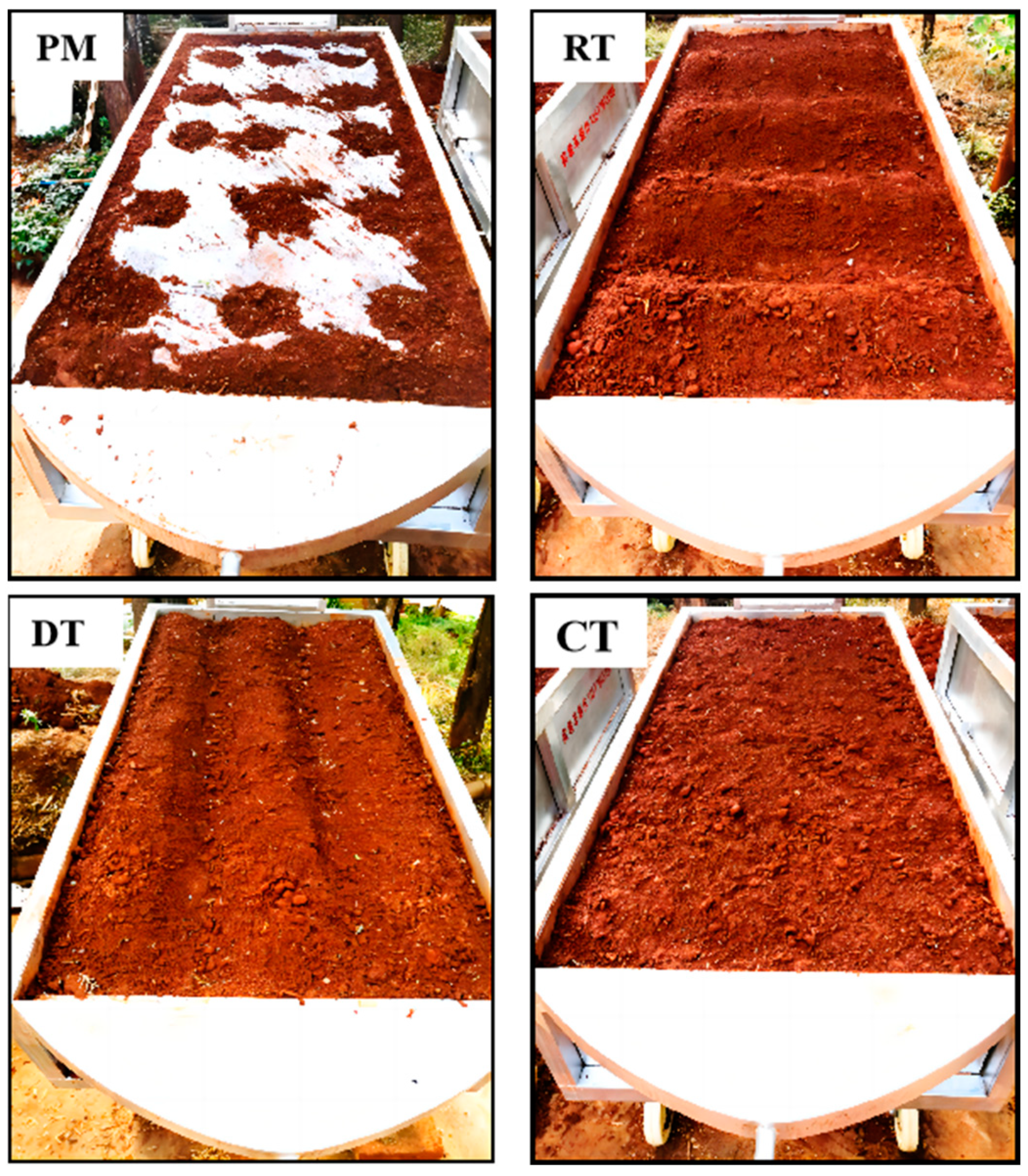
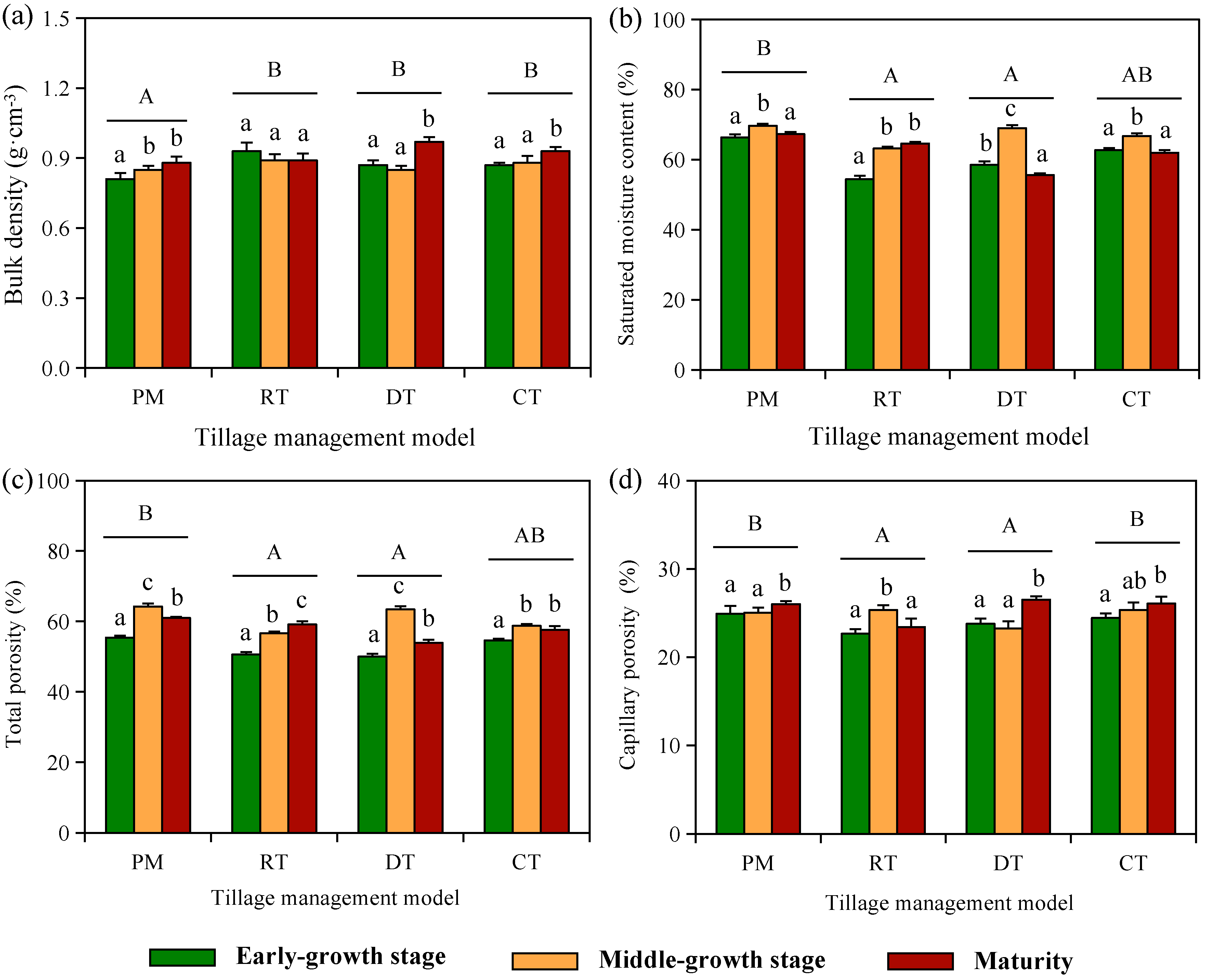


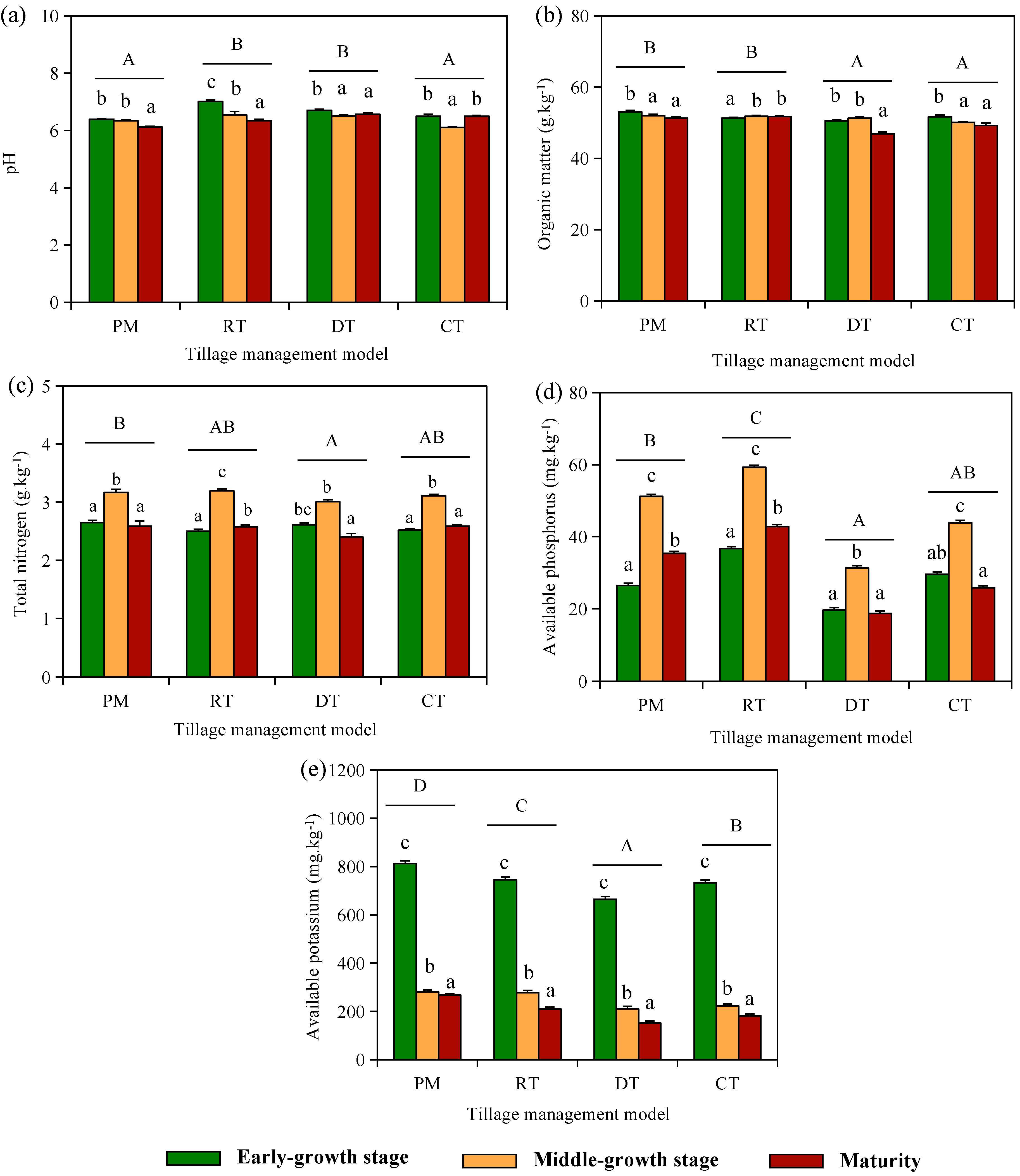

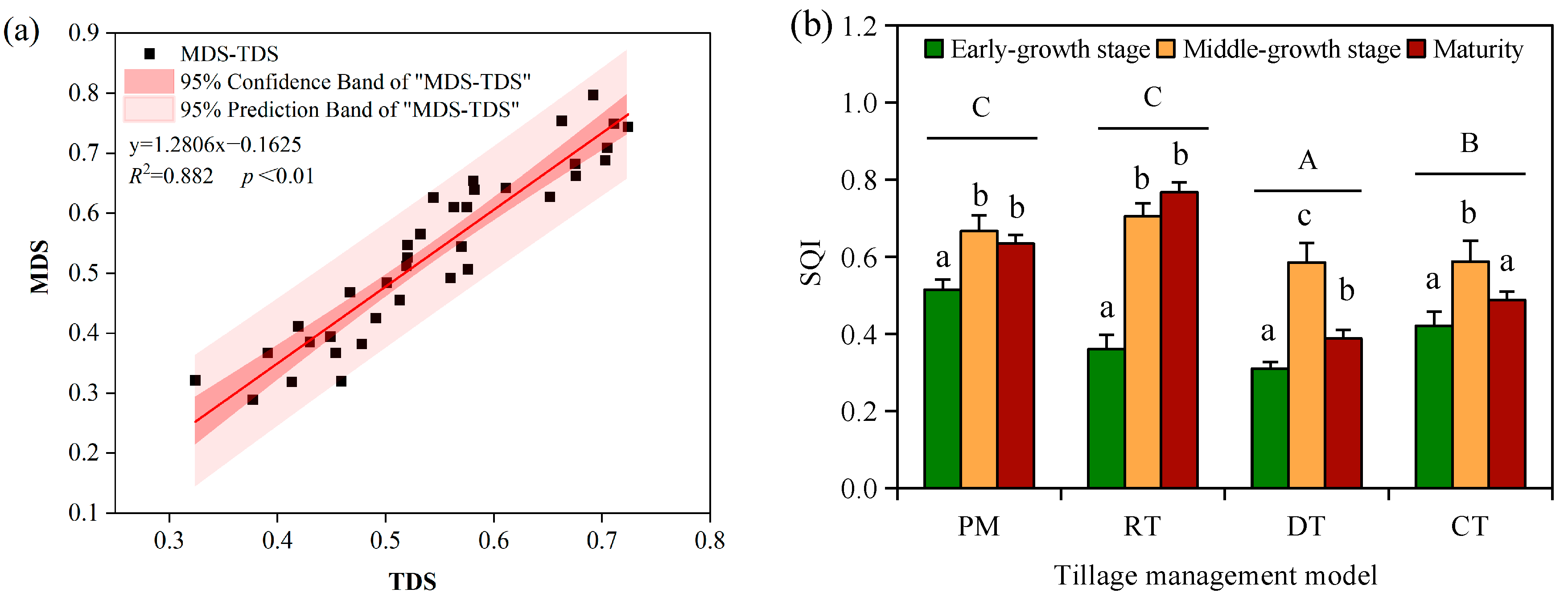
| pH | Mechanical Composition/(%) | Total Nitrogen (TN) | Organic Matter (OM) | Available Potassium (AK) | Available Phosphorus (AP) | ||
|---|---|---|---|---|---|---|---|
| Sand Particles (20–2000 μm) | Silt Particles (2–20 μm) | Clay Particles (<2 μm) | |||||
| 6.53 ± 0.22 | 49.58 | 35.86 | 14.56 | 2.66 ± 0.13 | 54.69 ± 1.21 | 673 ± 1.47 | 47.42 ± 0.27 |
| Soil Indicator and Abbreviation | Unit | Membership Function Type | Membership Function | Membership Function | Method Description/Instrument | |||
|---|---|---|---|---|---|---|---|---|
| a1 | b1 | b2 | a2 | |||||
| SMC | % | S-shaped membership function | 54.21 | — | — | 70.11 | Gravimetric with oven drying method [29] | |
| TP | % | 49.10 | — | — | 65.12 | Cutting-ring method [30] | ||
| CP | % | 22.11 | — | — | 26.92 | Cutting-ring method [30] | ||
| MWD | mm | 0.843 | — | — | 1.491 | The calculation method refers to the reference [31] | ||
| GMD | mm | 0.391 | — | — | 0.627 | |||
| WSAR | % | 68.12 | — | — | 75.94 | The calculation method refers to the reference [32] | ||
| OM | g·kg−1 | 45.520 | — | — | 53.405 | K2Cr2O7 colorimetric oxidization method [33] | ||
| TN | g·kg−1 | 2.480 | — | — | 3.240 | Kjeldahl method [34] | ||
| AP | mg·kg−1 | 17.92 | — | — | 59.70 | Sodium bicarbonate extraction, colorimetric [35] | ||
| AK | mg·kg−1 | 149.70 | — | — | 814.00 | 1 molL−1 NH4OAC extraction—flame [36] | ||
| BD | g·cm−3 | Inverse S-shaped membership function | 0.78 | — | — | 0.99 | Cutting-ring method [30] | |
| PAD | % | 24.06 | — | — | 31.88 | The calculation method refers to the reference [32] | ||
| pH | — | Parabolic membership function | 6.05 | 6.40 | 6.75 | 7.10 | Potentiometric method (1:5 soil–water ratio) [37] | |
| Indicator Code | Index | Group | Main Ingredient | Norm Value | Minimum Date Set | |||
|---|---|---|---|---|---|---|---|---|
| PC1 | PC2 | PC3 | PC4 | |||||
| X1 | BD | 2 | 0.008 | −0.886 | −0.085 | 0.257 | 1.638 | |
| X2 | SMC | 1 | 0.562 | 0.736 | −0.195 | −0.243 | 1.878 | √ |
| X3 | CP | 1 | 0.738 | 0.408 | −0.278 | −0.172 | 1.867 | |
| X4 | TP | 3 | 0.252 | −0.166 | −0.725 | 0.065 | 1.201 | |
| X5 | MWD | 2 | 0.741 | −0.56 | 0.114 | −0.132 | 1.964 | √ |
| X6 | GMD | 1 | 0.796 | −0.498 | 0.239 | −0.152 | 2.039 | |
| X7 | WSAR | 1 | 0.789 | −0.224 | 0.435 | −0.046 | 1.919 | |
| X8 | PAD | 1 | −0.813 | 0.234 | −0.431 | 0.038 | 1.971 | √ |
| X9 | pH | 1 | −0.655 | −0.349 | 0.423 | 0.308 | 1.739 | |
| X10 | OM | 3 | 0.099 | 0.755 | 0.583 | −0.087 | 1.614 | √ |
| X11 | TN | 4 | 0.47 | 0.444 | −0.224 | 0.695 | 1.549 | √ |
| X12 | AP | 1 | 0.654 | 0.363 | 0.298 | 0.56 | 1.765 | |
| X13 | AK | 1 | −0.759 | 0.313 | 0.448 | −0.064 | 1.905 | |
| Eigenvalue | 5.053 | 3.305 | 1.951 | 1.106 | ||||
| Variance contribution/% | 38.870 | 25.422 | 15.011 | 8.510 | ||||
| Cumulative variance contribution/% | 38.870 | 64.292 | 79.303 | 87.813 | ||||
Disclaimer/Publisher’s Note: The statements, opinions and data contained in all publications are solely those of the individual author(s) and contributor(s) and not of MDPI and/or the editor(s). MDPI and/or the editor(s) disclaim responsibility for any injury to people or property resulting from any ideas, methods, instructions or products referred to in the content. |
© 2024 by the authors. Licensee MDPI, Basel, Switzerland. This article is an open access article distributed under the terms and conditions of the Creative Commons Attribution (CC BY) license (https://creativecommons.org/licenses/by/4.0/).
Share and Cite
Yan, K.; Li, J.; Li, J.; Chen, Z.; Zhang, C.; Wang, D.; Hu, Y.; Wang, Z. Effects of Varied Tillage Practices on Soil Quality in the Experimental Field of Red-Soil Sloping Farmland in Southern China. Sustainability 2024, 16, 7843. https://doi.org/10.3390/su16177843
Yan K, Li J, Li J, Chen Z, Zhang C, Wang D, Hu Y, Wang Z. Effects of Varied Tillage Practices on Soil Quality in the Experimental Field of Red-Soil Sloping Farmland in Southern China. Sustainability. 2024; 16(17):7843. https://doi.org/10.3390/su16177843
Chicago/Turabian StyleYan, Keyu, Jing Li, Jianxing Li, Zhengfa Chen, Chuan Zhang, Daoxiang Wang, Yanmei Hu, and Zhongliang Wang. 2024. "Effects of Varied Tillage Practices on Soil Quality in the Experimental Field of Red-Soil Sloping Farmland in Southern China" Sustainability 16, no. 17: 7843. https://doi.org/10.3390/su16177843
APA StyleYan, K., Li, J., Li, J., Chen, Z., Zhang, C., Wang, D., Hu, Y., & Wang, Z. (2024). Effects of Varied Tillage Practices on Soil Quality in the Experimental Field of Red-Soil Sloping Farmland in Southern China. Sustainability, 16(17), 7843. https://doi.org/10.3390/su16177843







